
Text © DrSc Giuliano Russini – Biologist Zoologist

English translation by Mario Beltramini
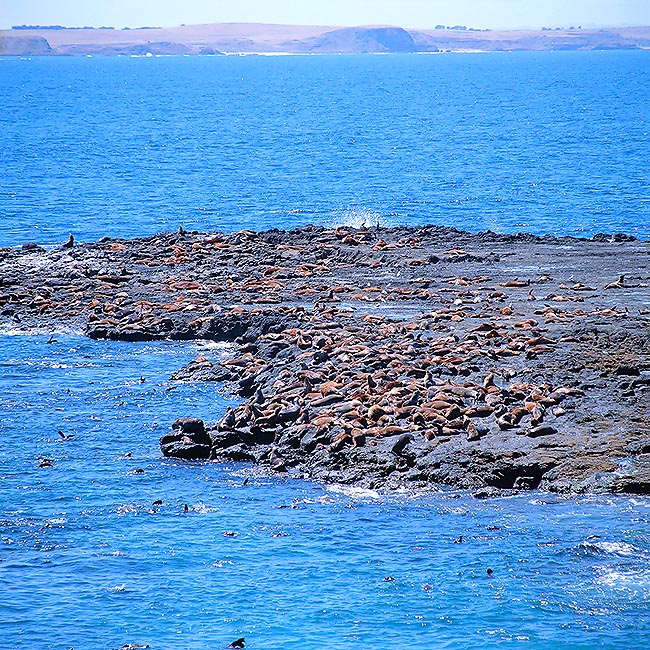
Flock of Arctocephalus pusillus doriferus on an islet of South Australia © Giuseppe Mazza
Pinnipeds are called the members of the superfamily of the Pinnipedia, sub- order Caniformia and order of the Carnivora, whose initial classification was proposed by the German biologist, entomologist and zoologist, Johann Karl Wilhelm Illiger in 1811 with its work “Prodromus Systematis Mammalium et Avium“.
Pinnipeds have a rather vast distribution range, often correlated to the cold water currents, which expatiates mainly in the Arctic, sub-Arctic, Antarctic and sub-Antarctic regions, with the close-by islands and coasts of the adjacent continents. But they are present also in the tropical and sub-tropical waters, and therefore we can talk of northern areas pinnipeds in the northern hemisphere and of southern species, meaning those living below the tropics, in the sub-Antarctic and Antarctic areas of the southern hemisphere.
We have to briefly remind that whilst the Southern Pole (Antarctica) is a continent formed by a platform extending for about 13 millions of Km2, covered all the year round by a perennial layer of ice, with a thickness varying between summer and winter, the Northern Pole (Arctic) is not a continent, but a rather ample area of sea covered by floating ices and delimited by the coasts belonging to different nations (USA, Canada, Green- land, Russia and Norway).
It is the Arctic Circle, with more or less thick ices, depending on the season and on the climate changes, as we have recently noted with the increase of the average temperatures produced by the greenhouse effect, connected to the global pollution phenomena. In the North Pole, the Arctic winter lasts several months. The sun never rises and the day has the same length as the night. Summers are short, but enough to allow the melting of ices. The mammals, and in particular the pinnipeds, can then move in the water, looking for food, and, alike several species of birds, convey, for the reproduction, to the coasts of the nearby continents.
In the Antarctic Pole, the presence of winds reaching the 160 km/h and of perennial ices cause the lowest temperatures in the planet. In the McMurdock zone, they have registered the absolute record of -131 °C! The fact that it is an enormous portion of terrestrial mantle covered by ices, allows, however, some species of animals, capable to bear the low temperatures and the strong winds, to reproduce also in situ during the summer time, when for about two months the weather is milder, and even some rare vegetal is able to grow up. In the back-country of Antarctica, they have sighted fungi, bacteria and algae; along the coasts, about 75 species of mosses, 20 species of hepaticae; and several species of lichens do vegetate in the sub-Antarctic archipelago of the South Orkney Islands.
Several vegetal species do grow up also on the rocks of the Arctic Pole, but in formations more complex than those observed in Antarctica. As the Arctic is somewhat warmer than Antarctica, all the vegetation characteristic of the sub-Arctic tundra, besides the lichens and other hepaticae, is found with about 1.000 species of mosses and 800-900 species of superior plants, such as the Arctic poppy and the moss campion. Some species get benefits from the short summer for producing flowers and berries, but usually, due to the hostile habitat, the reproduction happens by vegetative way, through stolons or bulbils carried by the wind (anemophily propagation). As a matter of fact, the reproductive cycle must quickly conclude, before the coming of winter.
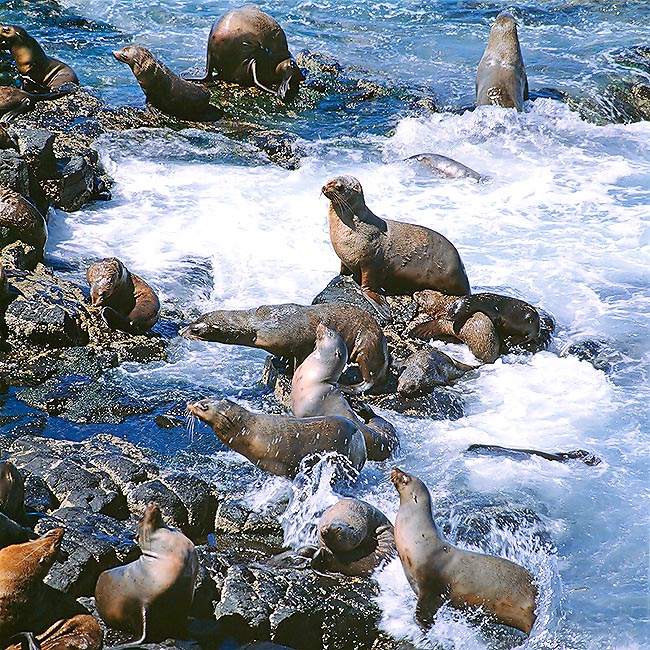
The females of Arctocephalus pusillus doriferus deliver as soon as the main land is reached © Mazza
This is also typical of various Antarctic species, such as, for instance, the sea birds belonging to the order of the Procellariiformes (petrels) and to the order of the Sphenisciformes (pen- guins).
In the case of the pinnipeds, both species northern and southern, utilize the coasts of islands or continents.
They are carnivorous, eutherian (pla- cental) mammals, which owe their name to their claws transformed into flippers and have adapted their body structure to the amphibian life.
Their body is fusiform and hydro- dynamic, covered by hair with a modified structure in respect to that of the other mammals, essential for the long marine immersions and a thick subcutaneous layer of fat (adipose tissue), protecting them from the polar temperatures.
The members of the superfamily of the Pinnipedia , commonly called seals, walruses, otariids, sea lions or sea wolves, have a common ancestor with the carnivorous, terrestrial quadrupeds.
They differed about 30 millions of years ago originating during the Miocene (23,03 millions of years ago) to the three following families, still extant:
►The Odobenidae with one species only, the Walrus (Odobenus rosmarus), counting 2 races or subspecies spread in the Boreal hemisphere: the Atlantic Walrus (Odobenus rosmarus rosmarus) and the Pacific Walrus (Odobenus rosmarus divergens).
►The Otariidae with 13 species like the Arctocephalus pusillus (with the race or subspecies Arctocephalus pusillus doriferus here shown) or the California Sea Lion (Zalophus californianus), called also rugged hair sea lion, very intelligent animal and suitable for training, and, in fact, it is the most common species of sea lion in the aquatic parks, zoological gardens and circuses.
►The Phocidae with 18 species, such as the well known Common Seal (Phoca vitulina).
Philogenetically, among the three families, that of the Phocidae is the one with the most ancient origin, the first one to differentiate from the terrestrial quadruped carnivores. Many biologists and zoologists assert, with zoo-paleontological and genetic data in their possession, that the members of the Phocidae, Odobenidae, Otariidae, have common ancestors with the cats (Felis silvestris catus) and the domesticated dog (Canis lupus domesticus). The Odobenidae live in the Arctic seas; the Otariidae are in the Atlantic and Pacific Oceans; and the Phocidae are present in the Arctic seas as well as in Antarctica, and in temperate tropical and subtropical waters. The seals, the best swimmers among the pinnipeds, are the only ones able do reach the great depths. In 1960 biologists applied a manometer on the back of a specimen of Weddell Seal (Leptonychotes weddellii), so named after the name of the biologist who described it during the second half of 1800, and they discovered that this seal could reach the depth of 550 m and remain in apnoea even for 70 minutes, whilst the other species of Phocidae cannot exceed the 20-30 minutes and the 350-400 m of depth.
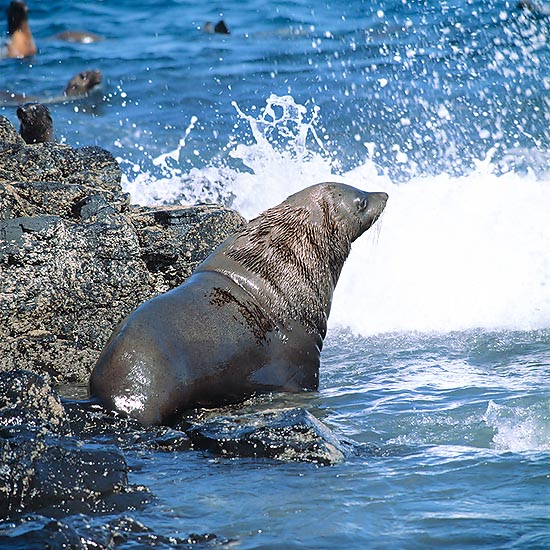
An impressive male of Arctocephalus pusillus doriferus © Giuseppe Mazza
Unlike the other families of pinnipeds, the seals can, in fact, hermetically shut, when in apnoea, thanks to a voluntary muscular system, the nostrils of their nose and the auditory meatuses.
Their ears have no pinnae and this renders them easily distinguishable from the group of the otaries, pinnipeds with analogous morphology, but having, on the contrary, a well developed outer ear with a fine pinna.
All the members of the three families are carnivorous; they eat crustaceans (krill), crabs, molluscs, cephalopods, and fish like anchovies, cods and herrings. In some instances, they eat greedily also penguins, young of other pinnipeds, or carcases of dead ones.
In the Arctic Polar Circle there are five species of Phocidae : the Ringed Seal (Phoca hispida), the Bearded Seal (Erignathus barbatus), the Harp Seal (Pagophilus groenlandicus), the Ribbon Seal (Phoca phasciata), and the Hooded Seal (Histriophoca cristata), which every day defy the icy marine waters looking for food.
All animals familiar with the pack, the area of ices or iced floating caps, and the small islands and the adjacent coats of Canada, Greenland, Russia, USA and Norway, where they often meet for changing their hair, breed the young and reproduce, as they are the only pinnipeds, along with the members of the Odobenidae, which can do this also on the floating ices.
It is to be said the Phocidae, in respect to the Otariidae and the Odobenidae, are those spending most of their time in water. They have, in fact, a more fusiform and hydrodynamic body, and even if they are amphibians, they have a particular morpho-physiologic development of the hind flippers, placed one in front of the other, without the possibility to bend forward. An unquestionable advantage when swimming, but a handicap on the dry land, as, being useless as a support, they originate a clumsy, difficult, crawling and warping locomotion. Among the predators of the Arctic species, we find the Orcas (Orcinus orca), but also the Polar Bear (Ursus maritimus), particularly greedy of the Ringed Seal (Phoca hispida) and of the Bearded Seal (Erignathus barbatus). When, as in summer, the food is abundant, a well nourished bear eats only their entrails and fat, leaving the remainder to the ravens (Corvus corax and Corvus corax corax), but when the nourishment is scarce, they are completely eaten.
In the Antarctic polar region there are four species of Phocidae : the Ross Seal (Ommatophoca rossi), the Crabeater Seal (Lobodon carcinopahagus), the Leopard Seal (Hydrurga leptonyx), and the Weddell Seal (Leptonychotes weddelli). These species have a home range extending from the sea to the coasts characterizing and delimitating the vast dry land platform covered by the ices of the South Pole, the Antarctic Polar Circle, but are found also on the coasts of sub-Antarctic regions, such as the South Orkney Islands, south-eastern Australia, New Zealand, Tasman Island, and South America. Here they are found both on the coasts of the extreme south of Argentina, like the Tierra del Fuego and on the extreme south of Chile, on islands such as the Falklands, and in South Africa on the coasts of the Cape of Good Hope.
Among the most common predators of these species of seals, we always find the Orca (Orcinus orca), and, in the waters off South Africa, south-eastern Australia and the northern coasts of New Zealand, also the great White Shark (Carcharodon carcharias), not to forget the Leopard Seal (Hydrurga leptonyx), which often preys the young of the other three species.
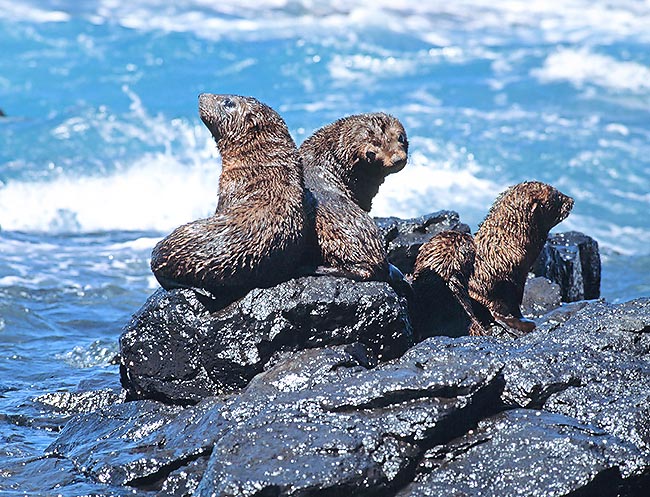
The Arctocephalus pusillus doriferus first months of life are the most critical of their existence © Giuseppe Mazza
Finally, some Phocidae living in tropical or subtropical waters do exist, such as the Monk Seal (Monachus monachus) and the Caribbean Monk Seal (Monachus tropicalis).
The first one is 80 to 240 cm long and can reach the 340 kg of weight. It mainly lives in water, even if does not disdain the coasts, where it rests and reproduces.
We can find it in the Mediterranean, where it forms colonies along the Sardinian and Sicilian coasts, and then along the coasts of Spain, Corsica, Morocco, Greece, even in the Black Sea waters, to which we have to add the Atlantic coasts of Spain, Portugal, Madeira, Mauritania and the Canary Islands.
Its population has had oscillations of density downwards during the ’80-‘90’s, whilst now, thanks to the programmes of repopulation and protection in marine natural parks, the biologists are stabilizing its population on higher numerical values.
Around the fifties we were convinced that the Caribbean Monk Seal (Monachus tropicalis) was at that time extinct, but in the sixties some biologists zoologists and marine biologists sighted some specimens, analyzed on the coasts of the Antilles and of the Caribbean. Nowadays, this species is considered as extremely rare, and is of course included into the red list of the Threatened Endangered Species of the IUCN.
Also the species of the genus Mirounga, the elephant seals, which, along with the walruses are the biggest pinnipeds, belong to the family of the Phocidae, as they distinguish in strict sense from the members of the family of the Odobenidae and Otariidae. Two species are known: the Southern Elephant Seal (Mirounga leonina), present in the southern Pacific Ocean and the Northern Elephant Seal (Mirounga angustirostris), found in the north-eastern Pacific Ocean. These two species do not have enormous differences. Both reach the 6 m of length and the 3,5 t of weight, with females of about 900-1000 kg, but the northern species has a somewhat smaller trunk.
The Mirounga leonina, the Southern Elephant Seal, was almost extinct during the 19th century, nowadays there are about 15.000 specimens, and its population is luckily increasing constantly. The very close extinction was due to the unlimited hunting due to the oil which can be obtained from these animals, even 400 litres from a 5 years old male. The Mirounga leonina is not literally Antarctic, in fact, even if at times it reproduces on terrestrial Antarctic ices, close to the open sea, usually it lives on the coasts outside from the frozen area. The common name of Elephant Seal is not coming only from its pachydermous mass, but from a thick-set trunk which hangs down on the mouth of the males, hiding the same. Absent in the females, it is a clear character of sexual dimorphism.
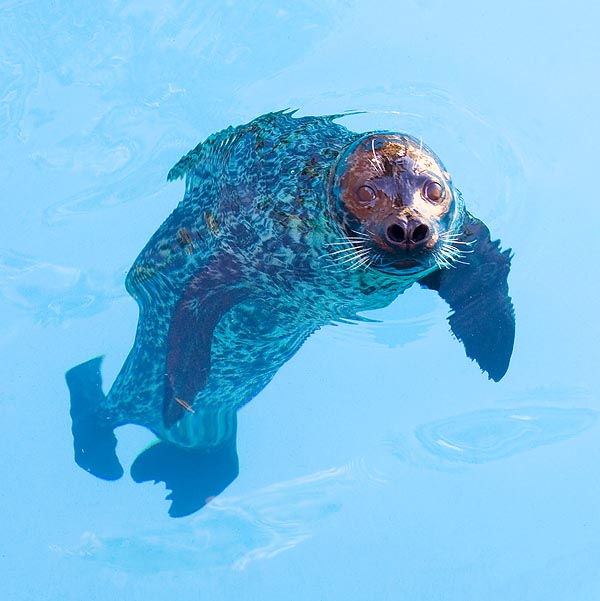
A Common Seal (Phoca vitulina) emerges from the icy waters for breathing © Giuseppe Mazza
During the heat season, the trunk swells out, probably due to endocrine stimuli caused by hormones like the epinephrine or adrenaline, which cause the muscular contraction and increase of the blood pressure. A sound bow to the strong shouts and cries of these animals, and an important visual stimulus for the females in oestrum.
The males reach the coasts in September, by the beginning of the Antarctic spring. The females follow them by the end of the month, entering the harem of the male which dominates the whole zone, called “king of the coast”.
Each harem is formed by a variable number of females, which can vary from 10-20 up to 30-40, but they have observed, exceptionally, also harems with 100 females.
These harems are formed by the dominant male, which is compelled to sustain a quantity of furious fights, from which, by the least, both winner and loser get out deeply wounded with showy haemorrhages, and even at times ending with the demise of the loser.
These deep wounds are caused by their canines and incisors.
When the two male pretenders confront, both in the southern and in the northern species, they assume a particular position, called at “U”. In fact, the back bends, and the tail directs towards the head thus drawing, with the body, the shape of the letter U. Usually, the complete lifting of the tail takes place in water, but it can happen also, with a certain frequency, on the dry land. Then the antagonists place one in front to the other, with the two trunks facing vertically, emitting powerful shouts. If none of the two gives up, the fight happens: 3,5 tons against other 3,5 tons in a ferocious fight!
The cries of the sexually mature and older males, both in the southern and northern species, have a metallic sound.
In the females of Mirounga leonina and Mirounga angustirostris, the deliveries are usually single, rarely double.
The young, seen the size, come to life after a 21-22 months long pregnancy. At birth, they measure about 1,20 m with 45 kg of weight, which increases at the incredible rhythm of 9 kg per day, thanks to a milk very rich in fats. The suckling lasts three weeks, and then they are weaned. On their hand, the mothers have lost one third of their physiological weight, and go back immediately to the sea for nourishing and for recovering about 300 kg. The young starve, and reach the sea for nourishing only by the fifth week of post natal life, after having changed the downy mantle which was covering them with a waterproof one. Every year, between December and January, also the male and female adults reach again the dry land to effect the moult. The elephant seal is the most long-living pinniped, as it reaches even the 75 years of age.
The foes of the elephant seal, for both species, are practically non existent, seen their size, but the Orcae (Orcinus orca), which can attack the young, threatened also by the Leopard Seals (Hydrurga leptonyx) when, inattentive, get far from the mother. In particularly rigid and poor of food seasons, the orcas, hungry, can attack also females and at times the males too, with apocalyptic fights. On a daily basis, the young often can die crushed by the males, during their fights, or because they bog into the ice when this melts by the summer season. At last, it often happens that also the males are trapped in the marshes where they are wallowing.
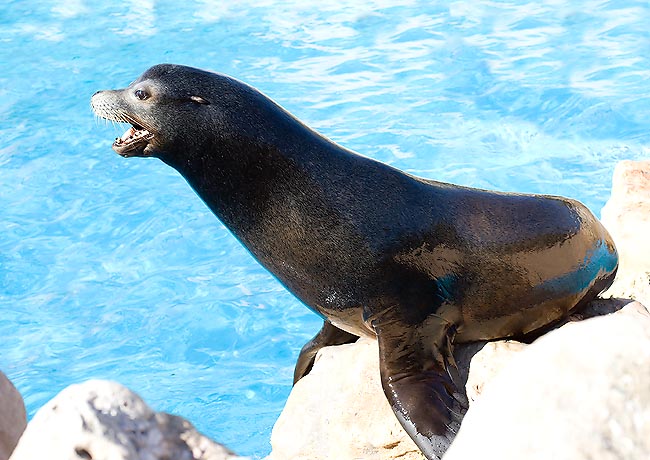
The California Sea Lion (Zalophus californianus) is an expanding animal © Giuseppe Mazza
The centre of origin of the Arctic seals is the North Pole. In fact, here the five aforementioned species do live all the year round.
The Ringed Seal (Phoca hispida) is the smallest in the family of the Phocidae, and also the most common at the extreme North.
Its common name comes from the presence of circular dots, darker at the centre, scattered on its back. Males and females have about the same size: 135-160 cm of length with a weight of about 90 kg. They live in small flocks and do not effect regular migrations. They usually stay not farther than 25 km from the coast, where the ice is firmly united to the land, hunting crustaceans and small fish. The females effect, as a rule, single deliveries, rarely double.
On the contrary, the Harp Seals (Pagophilus groenlandicus) live in huge flocks composed by more than a million and a half of specimens in the Gulf of Saint Lawrence and of a million when off Labrador, in Canada. They reproduce between February and March, with single deliveries. The mother suckles its young for 14-18 days and never abandons it during its first week of post natal life. During this stage, thanks to a highly nourishing milk, the baby increases its weight from 8 to 31 kg, accumulating fat, and till when the moult is not completed, it has a downy hair, candid white, which is cruelly hunted for the fur industry. Like the young of other Arctic seals, the baby starves during the moult, before the weaning when it starts nourishing autonomously of crustaceans. The adults, males and females, can reach a length of 180 cm and a weight of about 180 kg.
The Bearded Seals (Erignathus barbatus), so called because of the long shaggy whiskers, live, also them, at the borders of the ice pack, in the coastal waters. Usually, they are solitary, but small groups of 50 units can be observed during the time of reproduction, also in this case between February and March. Males and females weigh 225-270 kg and can reach a length of 225 cm.
The Hooded Seal (Histriphoca cristata), so called due to the presence of an expanding excrescence which stands only on the head of the males, thus evidencing a clear sexual dimorphism. When excited, they swell this cephalic protuberance and show a bright red nasal sac, similar to a bladder. It seems that this behaviour is indication of rage or of fear. Also the specimens of this species live solitary, but when they are migrating towards the areas chosen for the mating, where they share the space with the Harp Seals (Pagophilus groenlandicus). The pup of the Histriophoca cristata is commonly called “blueback”, due to the presence of these reflexes on the back when it changes its new-born white downy mantle into the adult’s grey one. Deliveries are usually single. The Hooded Seals are the biggest Arctic seals, as they reach, in both sexes, the 3,15 m of length and the 400 kg of weight.
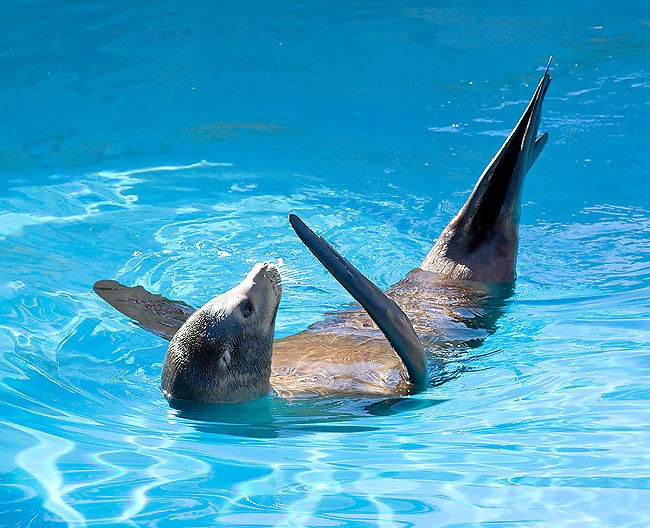
Little is needed to a Zalophus californianus for being happy © Giuseppe Mazza
The Ribbon Seal (Phoca fasciata), the last of the five Arctic species here described, has a size similar to the Ringed Seal (Phoca hispida) and lives, solitary, in northern Pacific.
Rather rare, it can be identified due to the presence of yellowish stripes on a chocolate coloured background. It is an animal typical of the floating ices (pack), with which it moves southwards in winter, for coming back to north in summer. It seems, but the data are to be confirmed, that the pups come to life on the floating ices. Deliveries are usually single.
For what the four species of Antarctic seals are concerned, they all do belong to a same group, contrarily to the Arctic seas which do not have specific ties between them. Like the northern ones, they share the same habitats, home ranges and biotopes for the reproduction, nutrition and moult, that is, sea, beaches, coasts, terrestrial ices and pack. They have a similar alimentary ecology: crustaceans (krill, crabs), fish, but also penguins and carcases of dead pinnipeds. Nevertheless, the four Antarctic species, even if having a common group of origin, have different styles of life. For instance, the Leopard Seal (Hydrurga leptonyx) is very nimble in water and is a well known hunter of penguins and young pinnipeds. It is able to set deadly traps, but can nourish also of krill and carcasses. The Weddell Seal (Leptonychotes weddelli) provided with great resistance in immersion, lives mainly along the sub-Antarctic coasts, nourishing of squids and fish, caught also at 550 m of depth. When it re-emerges for breathing, after even 70 minutes of apnoea, it is capable to break with the teeth the thinnest points of thee ice.
Being mammals, like anyway the cetaceans (order: Cetacea, suborder Odontoceta : dolphins, grampuses and sperm whales, with conical teeth and suborder Mysticeti : whales in the literal sense, rorquals, humpback whales do have baleens in lieu of the teeth), the seals in fact breath with the lungs, and are compelled to periodically return to the surface for storing oxygen. In the case of the Weddell Seal, the quantity of oxygen caught by the haemoglobin of the blood is much bigger than for the other seals, and five times superior to that which can be accumulated in the human haemoglobin. Furthermore, it has been observed that with greater efficiency than the other seals and well beyond the human capabilities, in these animals the oxygen consumption in immersion is remarkably reduced, thus ensuring even in critical situations the circulation and the blood perfusion of organs, like the brain, which cannot stand without oxygen. The skeletal striated muscles operate utilizing their reserves of oxygen, and the lactic acid produced by the muscular work is kept till when the animal does not re-emerge. Only at this time, it will be discharged into the blood and converted, by glycogenesis, in glucose, the main source of sugar metabolized by animals and plants. The Crabeater Seal (Lobodon carcinophagus) lives mostly in the pack, nourishing of krill and crabs. This species, the most common in the Antarctic seas, is called also “the seal which changes colour”, due to the characteristic toning of its coat which, during the year, changes from white to cream-white.
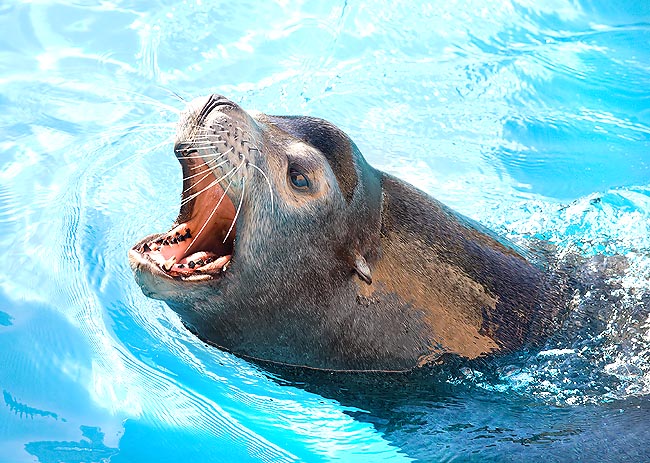
The California Sea Lions are famous for their powerful vocalizations © Giuseppe Mazza
Finally, the Ross Seal (Ommatophoca rossi), which swims in the half-light under the floating ices, has very big eyes, esophthalmos, which permit to localize, even in conditions of scarce light, squids and fish of several species. This wonderful animal, which gets its name from the biologist Ross, its discoverer in 1860 during one of the first expeditions in Antarctica, is very seldom sighted as it lives on the remote pack. Little is known about its biology.
The females of all four Antarctic species effect single deliveries, rarely double. The family of the Odobenidae, as already shortly said, has only one species: the Walrus (Odobenus rosmarus). This has two subspecies or races in the boreal hemisphere: the Odobenus rosmarus rosmarus, called Atlantic Walrus, and the Odobenus rosmarus divergens, known as Pacific Walrus. Both males and females of walrus are provided with tusks, that is long grown canines. Longer in the males, they average 75 cm, but can even reach the metre.
The Pacific subspecies has bigger size and nostrils placed higher on the snout. Apart from these differences, the two subspecies or races are very similar in the look and behaviour. One third of the weight of these animals, which can be close to the ton and a half, is formed by layers of fat which can reach a thickness of 6 cm, followed by a hard and bristly cutis of analogous thickness.
They have a clay-pink coloured coat, which becomes greyish pale when they spend, as it usually happens, much time in the cold waters of the Pacific and Atlantic oceans. This is a consequence of the constriction of the cutaneous capillaries, which convey less blood in surface, which then will disappear when the animals go back to the dry land for staying in the sun. In this case the opposite effect takes place: the expanding of the capillaries helps them in dispersing the summer heat. Thanks to this technique, and the adipose tissue which renders them practically insensible to the polar coldness, the walruses are capable to well adapt both to the cold and the heat.
The males can reach the length of 3,60 m with a weight of 1,5 t, the females can be about 2,80-3 m long with a weight of 660-700 kg. The mean lifetime of these animals is of 30 years, but there have been instances where the longevity has reached the 50 years. When one year old, the tusks of the young are about 2,5 cm long, then will grow quickly. Those of the females, besides being shorter, are also less robust. The animal utilizes them for getting on the ices from the water (from this the scientific name Odobenus, which means “to walk with the teeth”), for digging in the ice looking for molluscs and crustaceans, of which it is greedy, for opening a passage when it re-emerges for breathing, and for fighting against its competitors or the seals, which easily guts by swimming upside-down or on a side.
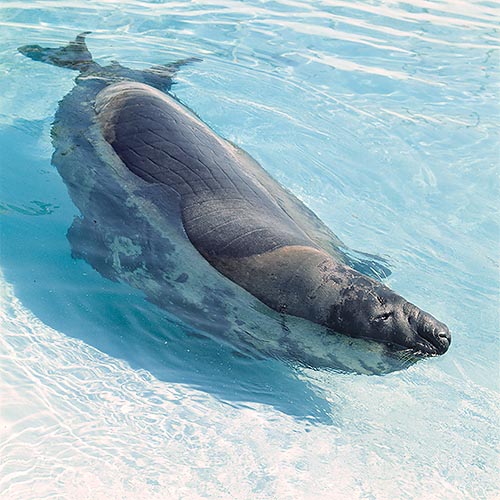
Mirounga leonina © Giuseppe Mazza
Their immersion autonomy is of about 12 minutes, therefore they have to look for food down to a maximum depth of 75 m. The molluscs and the crustaceans (krill) they eat, must be particularly abundant, as each walrus needs about 3.000 molluscs per day, and each group of walruses is composed of some thousands specimens.
Furthermore, its home range must be characterized by the presence of ice packs or accessible beaches where to rest. The outliving of these incredible and splendid animals is therefore really connected to the balance of the frail habitat and of the fish species.
The females reach the sexual maturity when about 5 years old, the males when about 6. After a pregnancy lasting about one year, the pups (deliveries are usually single, rarely double) come to life on the ices, during the migration northwards to the areas of the summer moulting. A walrus, upon its birth, weighs about 35 kg and has a length of 110-120 cm. During the first three weeks, its life totally depends from the mother, which gives milk and protects him from the cold, as the body of the pup has not yet accumulated enough fat to form the adipose tissue of the adults. These ones have well adapted to live between ices and sea, good and strong swimmers with even 90 cm broad hind flippers. Moreover, they can be turned forward and allow a good and co-ordinate terrestrial walking with a speed of 5 km/h, similar to the human gait.
When waterborne, the walruses sound the bottom with their tusks, looking for molluscs and crustaceans, or they take them off from the reefs thanks to the strong muscles of their lips, after having ascertained their presence with the whiskers. Due to their powerful size, they do not have natural foes, but the killer whale (Orcinus orca), and must, in case, fear the sicknesses caused by some forms of crustaceans and other parasites. It happens, at times, that the old males kill some seals for eating them or the do the same with the young of their own species. The origin of such cannibalism is unclear to the biologists. Perhaps, it has the aim to equilibrate the population in a specific home-range. Anyhow, the walruses applying this practice are identifiable by the dots on the tusks and a more unctuous skin.
Between the members of the Otariidae, besides the species of the austral hemisphere, with the Kerguelen Fur Seal Eater (Arctocephalus gazella), so called in honour to the German war vessel SMS Gazelle, which collected it around the 1840, and the Arctocephalus pusillus of which we show the subspecies Arctocephalus pusillus doriferus on the south-eastern Australian coasts, there are also those of the boreal hemisphere. The northern eared seals form the biggest groups of mammals on the planet earth: about 2 millions of specimens who reach two of the Pribilof Islands in the northern Pacific. Even nowadays the hunters kill up to 60.000 specimens per year, and in spite of this hunting practice the population keeps constantly on the 2-2,5 millions of specimens. This because the males, being polygynous, may have a harem of even 50 and more females, with which they couple by June, during the heat season, with very consistent progenies.
In October, the Northern Furs Seals (Callorhinus ursinus), begin the migration of about 4.500 km towards Japan and California, for leaving later northwards by the beginning of the springtime.
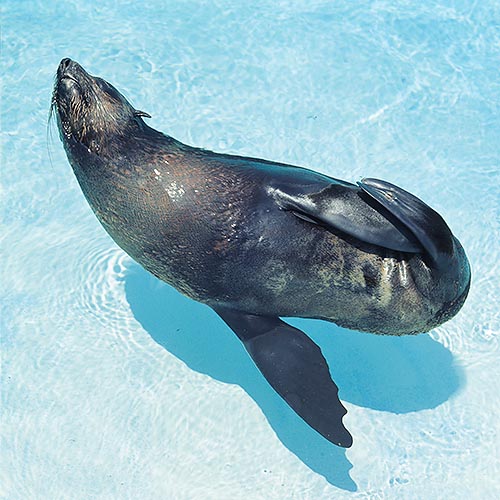
Arctocephalus gazella © Giuseppe Mazza
In the bigger eared seals, called also “sea lions”, the deliveries are single, like the other ear seals, rarely double. The males, macrocephalic, have a very robust neck and are taller than the females.
Those of the Steller Sea Lion (Eumetopias jubatus), southern species living along the meridional Australian coasts, of the New Zealand and South America and gets the name from the biologist and zoologist who discovered it by the second half of the ‘800, are rather rare to observe.
Much bigger than the females, the have a thick mane, and can reach the 3,30 m of length and 1 t of weight.
In these animals the fecundation happens immediately after the delivery.
The nourish of cephalopods, fish or penguins, and in presence of predators they can run away or defend with their powerful canines, and in fact, the killer whales prefer to keep away from them and hunt their pups.
Other northern and southern species of eared seals are: the California Sea Lion (Zalophus californianus), the Australian Sea Lion (Neophoca cinerea), the Patagonian Sea Lion (Otaria byronia), the Hooker’s Sea Lion (Phocarctos hookeri) and the previously cited genus Arctocephalus , living in the southern hemisphere.
